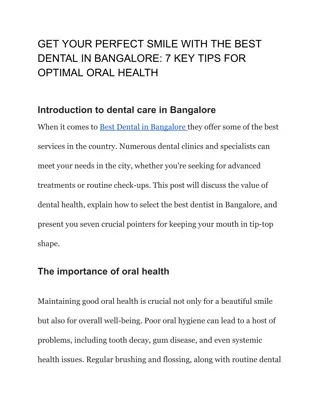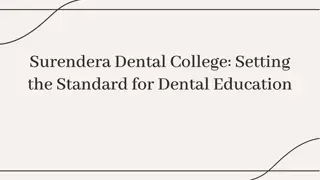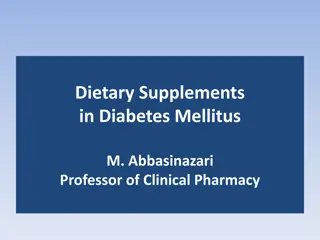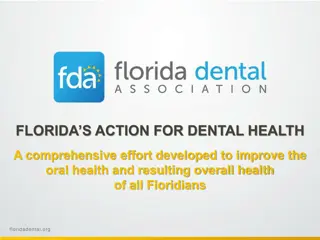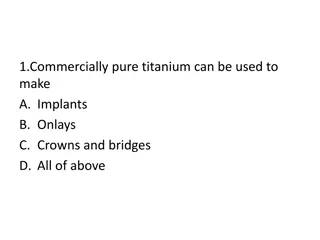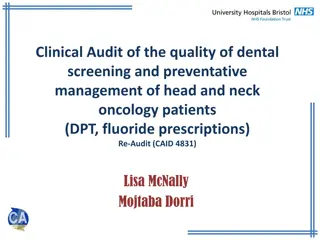Fluoride Supplements for Dental Health
Fluoride supplements are recommended for individuals living in non-fluoridated areas or at high risk for cavities. They come in various forms like tablets, drops, or lozenges, providing systemic fluoride to prevent tooth decay. Dosages vary by age and fluoride levels in drinking water, with studies showing significant caries reduction when taken properly. Different methods, such as fluoride tablets and drops, are available for supplementation. Additionally, fluoridated salt is another option to enhance dental health through daily consumption. It is essential to follow dental professionals' recommendations for the effective use of fluoride supplements.
Download Presentation

Please find below an Image/Link to download the presentation.
The content on the website is provided AS IS for your information and personal use only. It may not be sold, licensed, or shared on other websites without obtaining consent from the author.If you encounter any issues during the download, it is possible that the publisher has removed the file from their server.
You are allowed to download the files provided on this website for personal or commercial use, subject to the condition that they are used lawfully. All files are the property of their respective owners.
The content on the website is provided AS IS for your information and personal use only. It may not be sold, licensed, or shared on other websites without obtaining consent from the author.
E N D
Presentation Transcript
Fluoride supplements Dr. Rihab Abdul Hussein Ali B.D.S , M.Sc. , PhD.
Fluoride supplements were originally designed to provide the systemic fluoride that a child would not consume living in a non-fluoridated area. Fluoride supplements should only be prescribed by dentists where there is clear evidence for high risk of caries and non-compliance with using other fluoridated products. Also for disabled children and those with chronic diseases. Tablets, drops and/or lozenges: This is effective method in reducing or prevention of dental caries.
Fluoride tablets were introduced in the late 1940s to try to mimic the systemic fluoride delivery from water fluoridation, and most used sodium fluoride. Fluoride tablets became the method of choice for fluoride supplementation, it can be chewed and swallowed. The American Dental Association (ADA) Recommended Fluoride Supplementation Schedule as follow:
Fluoride supplement dosage according to fluoride in the drinking water (parts per million) Age <0.3 0.3 0.6 >0.6 Birth to 6 months None None None None None 6 months to 3 years 0.25 mg/day None 3 to 6 years 0.5 mg/day 0.25 mg/day None 6 to 16 years 1.0 mg/day 0.5 mg/day
Studies recommended the prescription of F tablets at 3 years of age by giving 0.5 mg/day till 13-15 years. It is better to be given daily once or twice a day. Studies reported that tablets taken during first 7 years of life provide caries reduction of 39% to 80%. NaF 2.2 mg=1mgF, 1.1 mg=0.5mgF. Tablets should not be given with milk. More caries reduction in child s primary teeth when pregnant women (0.4 ppm F in maternal blood) and breast feeding taken 1mg F daily.
Fluoridated drops are available in: - 0.125mg - 0.25mg - 0.5mg - 10 drops=1mg/L=1ppm.
Fluoridated salt The idea of adding fluoride to table salt originated in Switzerland following the success of adding iodine to help prevent goiter in 1955. Salt is usually fluoridated at 250 ppm (which is 250 mg F/kg salt, or 0.25mg/gm salt). Fluoridated salt in form of KF and NaF. Table salt in the kitchen can contribute 1 to 4g of the daily salt intake. Thus, a person could potentially ingest 1 mg of fluoride a day at a salt intake of 4 grams a day.
Some restrictions remain in effect in Europe, however, in that fluoridated salt cannot be added to commercial products or to food at restaurants. In a theoretical basis, fluoridated salt should provide some protection against caries because it increases salivary fluoride levels when the meals prepared with fluoridated salt are ingested. Consumption of fluoridated salt is lowered during early life when the need for fluoride is the maximum. Salt fluoridation needs community education and promotion.
Limitations Children, adults and elderly with hypertension. Advantages - Low cost. - Effective in caries reduction for primary and permanent teeth.
Fluoridated milk It is the addition of a measured quantity of fluoride to bottled milk or packaged milk to be drunk by child. The bioavailability of F in milk is in similarity to water. Human and bovine milk contain very low concentration of fluoride 0.03 ppm. However, it appears that the majority of fluoride is available in milk up to a concentration of about 5 ppm. F milk can be used in home and school programs with caries reduction of 70%.
Disadvantages: 1. High cost 2. Some people dislike milk. Fluoride fruit juices are an alternative method of fluoride delivery that may be appropriate for warm climates. A high concentration of fluoride is needed for two reasons: (1)The children did not drink the beverage throughout the day and (2)Calcium in the milk complexes with fluoride, which would reduce its availability for topical benefits.







